This story, chronicling my attempt to overhaul the jeep XJ's cooling system and overcome a mysterious overheating problem, was orignally posted to the website cherokeeforum.com. I ended up replacing the entire cooling system except for the heater core, and in the end it's vastely improved yet the motor still runs a little hot in the summer.
And just after installing new spark plugs, I drove to my brother's house about 30 miles away and that's when the radiator decided to explode... :(
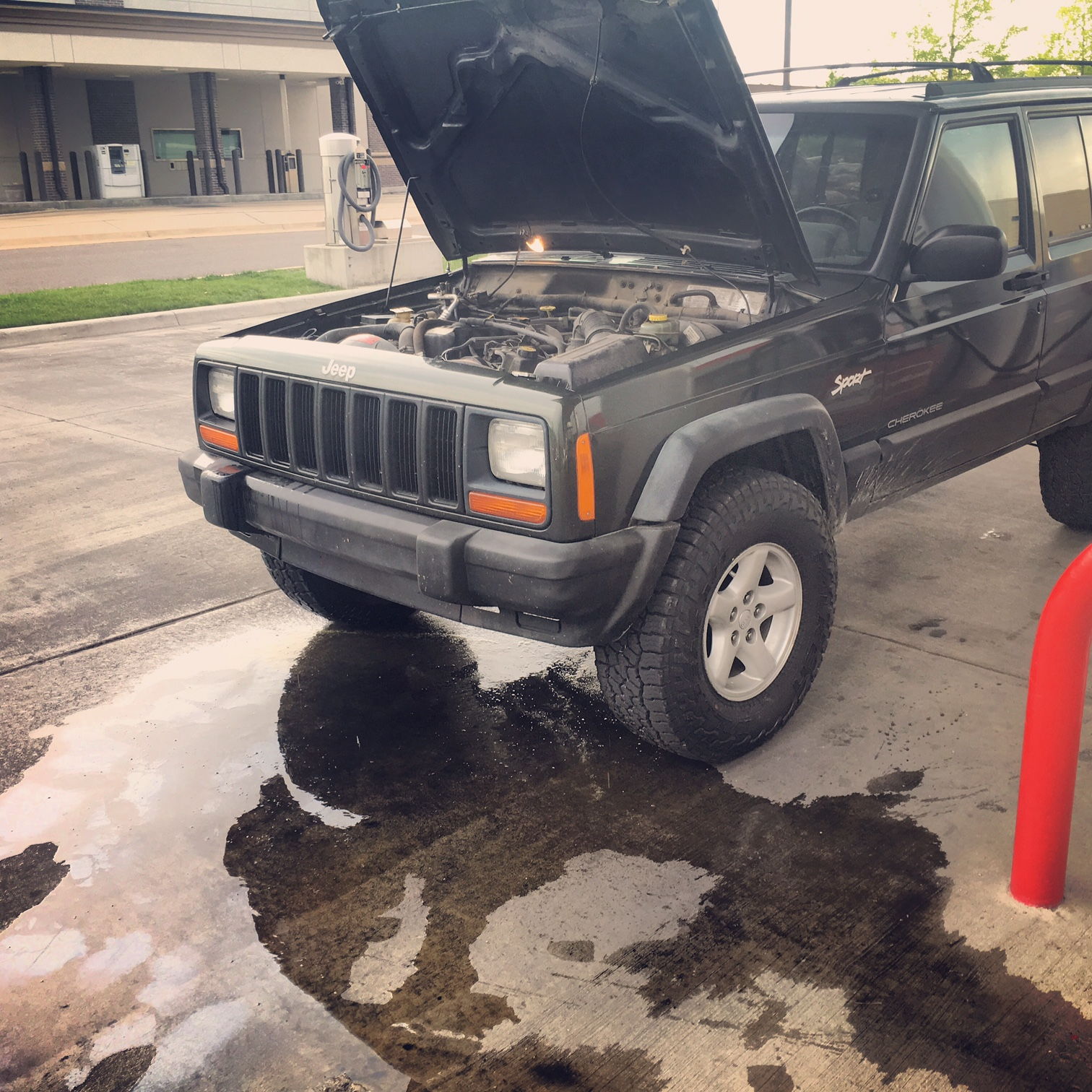

Had to get towed. $100 bill :(
-------
Alright here's what happened. Going to the interstate, first time with the larger tires, I noticed the temperature gauge went up slightly. It went one tick past the middle tick and nowhere near the danger zone, but still hotter than I've ever seen it. The temp sensor was just replaced last year so I trust it.
I also noticed a new noise coming from the engine. Hard to describe it, but I would say it was cross between a tick and a gurgle. Only at highway speeds (rpm around or over 2k) and when accelerating or going up a hill.
And finally I was running out of gas so I pulled over to fill up. Turned off the motor and that's when the radiator burst open. Steam went everywhere and all my coolant went onto the pavement. The lady in the gas stall next to me was like "oh my!!"
I opened the hood and touched the top radiator hose and it was not so hot that it burned me. It didn't smell like it overheated either, though the coolant steam was the dominant smell for sure.
Right now I have to decide if I want a radiator from Oreilly's or autozone or similar, or get an all-aluminum one ordered from a website. The former means I will have it repaired in time to go to Colorado, and the later means I will have a better radiator for about the same price.
I ordered a premium radiator from Oreilly's. It's a 2-row, copper core and has plastic sides, and it cost $200 after taxes. However, it was damaged in shipping and the plastic side was cracked at the filler neck. I returned it and got my money back and had them order a new one that will be in today.
I think that if the new one is not cracked then I will use it. The old radiator that failed on me, it was the plastic side that burst open, but it was five years old. I don't know if I'll have the jeep for longer than that so I think I will go with that one as my short-term goal is to drive it to Colorado and put the $1500+ in upgrades to their intended use, and my long-term goal is to get the Jeep to 300,000 miles.
Here's the receipt from the last time the radiator was replaced, over five years ago. It says it's a radiator for a right-hand-drive Post Office vehicle. [Update: I failed to read the reciept correctly. What it's really saying is that the radiator is for vehicles EXCEPT right hand drive post office vehicles.]
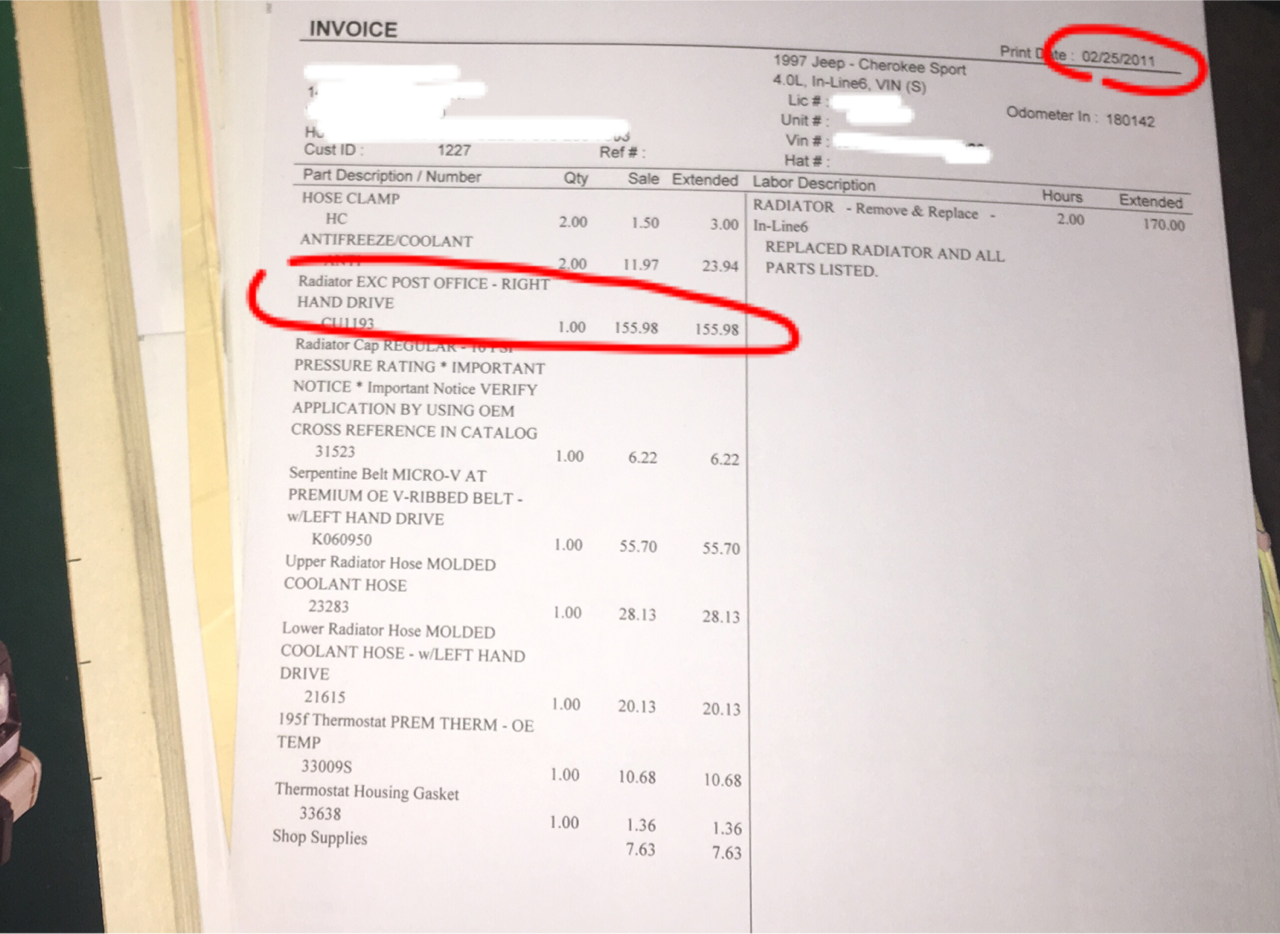
Removing the old radiator wasn't that hard.
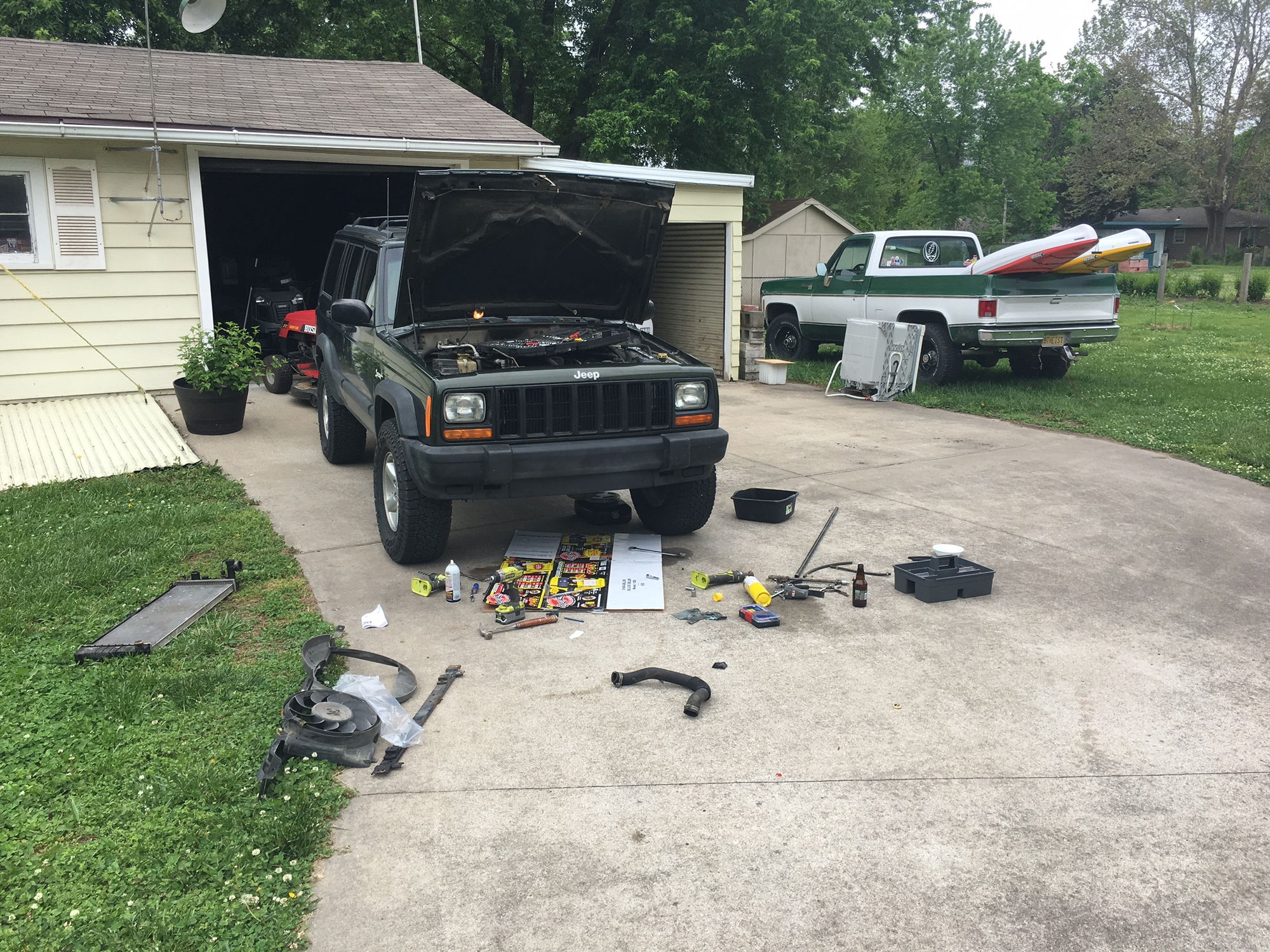
However, I couldn't remove the upper transmission oil line without bending the metal tube so I just cut it off. The lower tube I just pulled off and I think I broke it.

So my solution was to install an auxiliary transmission oil cooler. I got the "medium duty" one from Oreilly's for $50 though, now that I think about it, maybe I should have gone with the heavy duty one because it was only a few bucks more and overkill is usually better than underkill.
I'm mounting it to the front of the AC condenser. It will be visible behind the grill but it's the best place to put it. It was pretty easy to install. It came with rubber hoses and hose clamps to connect it to the factory transmission oil lines.
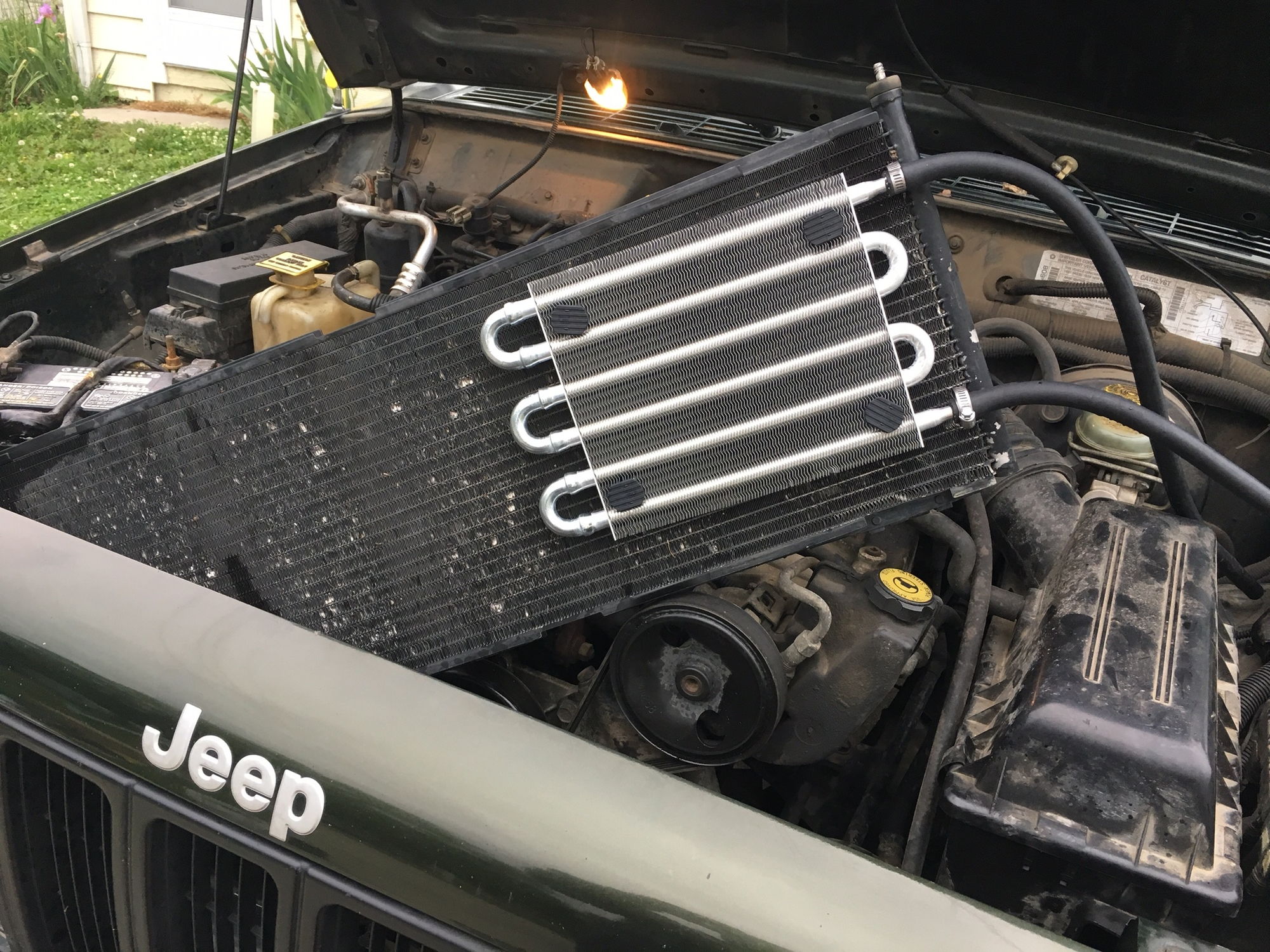
[Update: I later moved the transmission oil cooler to the passenger side so that the belt-driven fan would always be blowing air over it, while the electric fan on the other side would only be spinning if the engine temp rose over 215*]
While waiting for the new radiator to arrive, I installed the steering box spacer and steering brace. It was a great time to do it as the lack of a radiator provided some extra elbow room.

After installing the larger tires and the suspention lift, I took it for a test drive. The good news is that I didn't get it stuck in the mud but just barely.
The bad news is it overheated. It happened on the highway on the way to the little trail. I know that it really did overheat and not a bad temp gauge because the water was boiling into the overflow tank.
The next day I replaced the fan clutch hoping that that was the problem. Then I drained the water + flush additive out of the radiator and this is what came out. Gross!

With a new fan clutch, new 50/50 coolant mix, and a bottle of Wetter Water in the radiator, I was feeling pretty confident I had the overheating problem fixed!
Wrong...
10 minutes on the highway and the temp starts to creep up, just like it did before. About halfway between 210 and the red tick I pulled off the highway and that's when it really boiled out of control. Boiling water doesn't cool very well and it becomes a feedback loop. I turned off the engine for five minutes, turned it back on and let it idle for a little while to circulate the coolant and it didn't take long for it to go back to normal temp.
Drove back extra slow and it was fine..
That all took place about a week ago. I obviously did not go to Colorado as planned. :(
But, I have a new water pump, and I'm optimistic. I will drive this turd to Colorado if it's that last thing I do!
Checking to see if I have a blown head gasket before replacing the water pump. This morning I tried doing the "block test" (that's what Oreilly's calls it) to check for combustion gases in the coolant.
But it was a highly flawed test, at best, and at worst it was a completely worthless experiment that spilled coolant everywhere. The problem was that coolant was rising into the test tube and mixing with the test fluid.

You can also see that the coolant/fluid in the test tube is a little bit yellower/browner than the coolant showing in the filler neck of the radiator. The blue test fluid is supposed to turn yellow in the presence of combustion gases.
[Update: I later did the test a 2nd time but after draining the radiator half way first. The test successfully tested negative for combustion gases.]
Yesterday I drained the stuff out of the cooling system after driving around for two days with the Blue Devil additive in the water to help it clean everything out.
It was pretty dark, dirty and nasty. That should be about 30% old coolant (hor however much remains in the block after draining the radiator), 65% distilled water, and 5% blue devil flush additive.

This is what inside the head's coolant passage looks like with the thermostate removed. What the hell is in there?? Even after flushing once with the Prestone flush additive and once with the Blue Devil flush additive....

I removed the old water pump and inspected the blades and they were perfectly fine. I'm 99% sure there was nothing wrong with the old water pump now, but I had to be sure.
Next, I smoothed out the inside of the thermostat housing to help flow. The inner angle of the right angle bend was particularly sharp before applying the dremel to it.
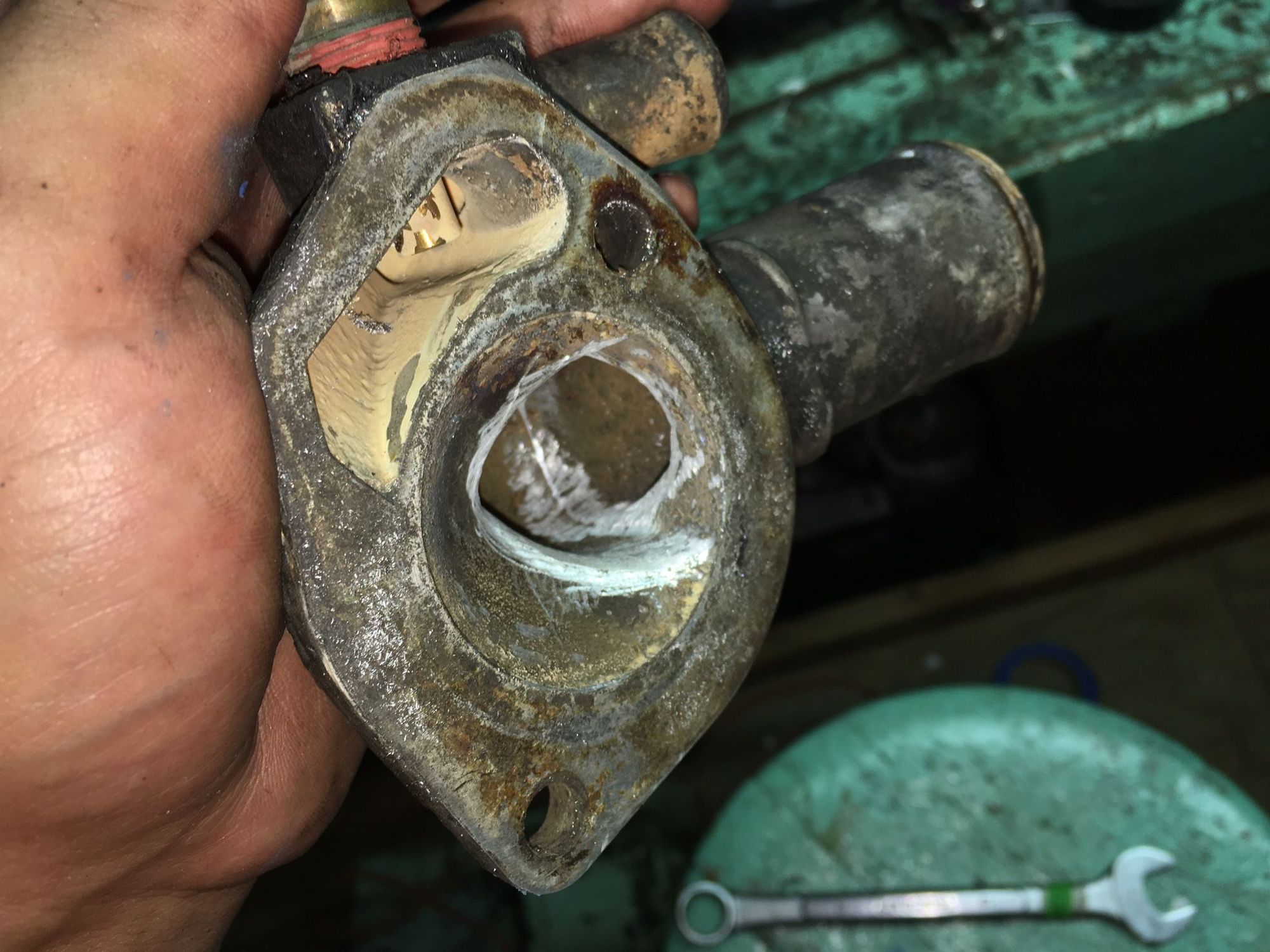
I did a little science experiment to see which thermostat I wanted to use. I had a 195*f one from Oreillys, another 195*f one from Autozone, and 180*f Stant Superstat from amazon.
I bought the 180 superstat thinking the extra 15* would give me a heads up that the coolant temp is creeping up again. I know that it wouldn't help the cooling system shed heat any better. But after reading that the engine needs to run at the temp it's designed to (the motor oil performs better at that temp, the computer and O2 sensor like it better too, and it gets better gas millage) I thought I would return it or put it on the shelf somewhere..

Turns out that the two cheap 195*f thermostats opened up well before the 180*f superstat! So that's what I chose to use. Maybe I'll buy a proper 195*f superstat later down the road... In the above pic you can see that all three were open at 185*f. IIRC the two cheap ones opened up well before then, around 170*f.
Although the old water pump was fine, I put in the new one just because why not, it's not that expensive and I already had purchased it.
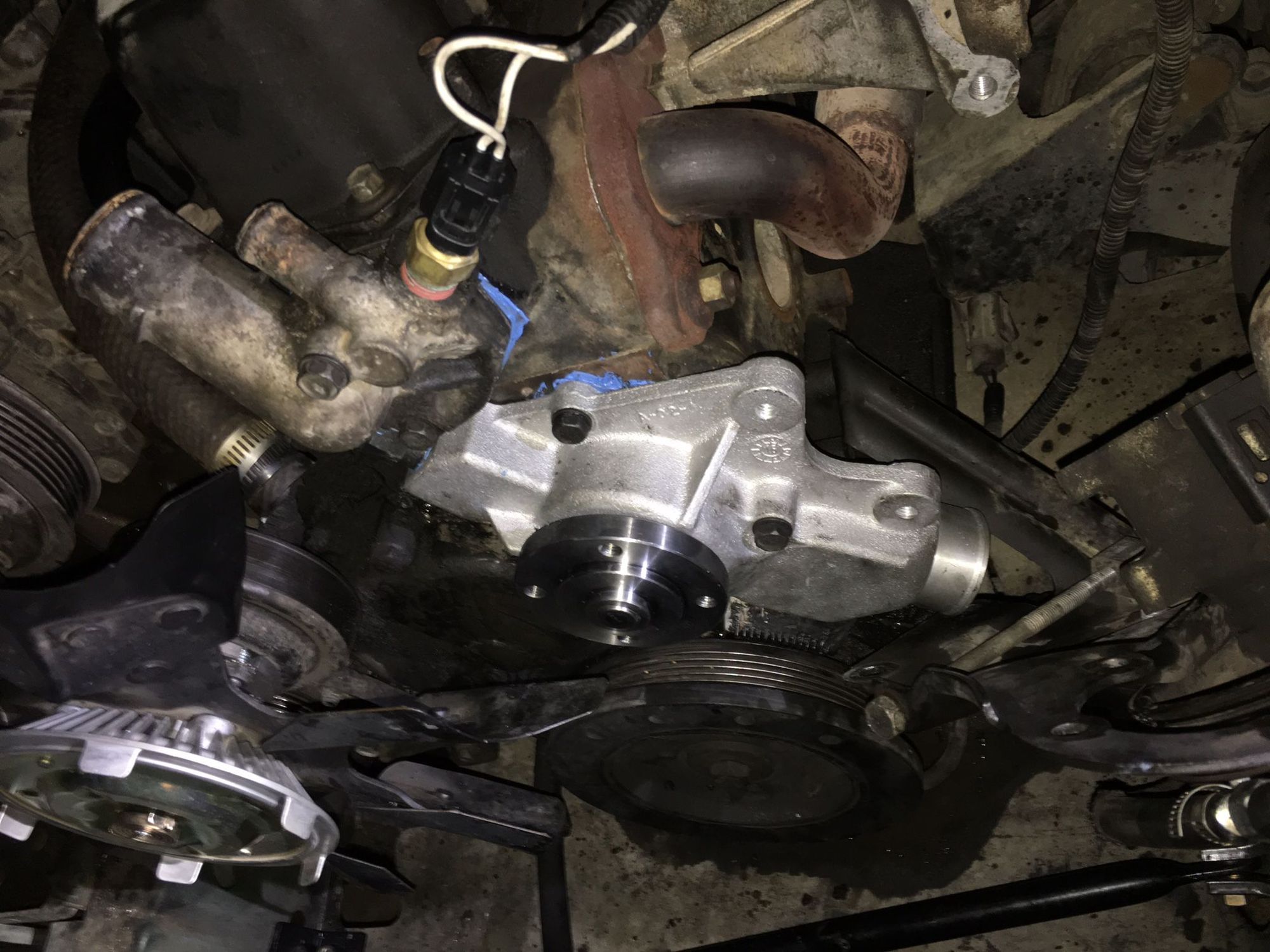
Now I just have to put everything back together
The mix of what I estimate to be 30% old coolant (or however much remains in the block after draining the radiator), 65% distilled water, and 5% blue devil flush additive after letting the flush additive do it's job for two days of normal city driving:
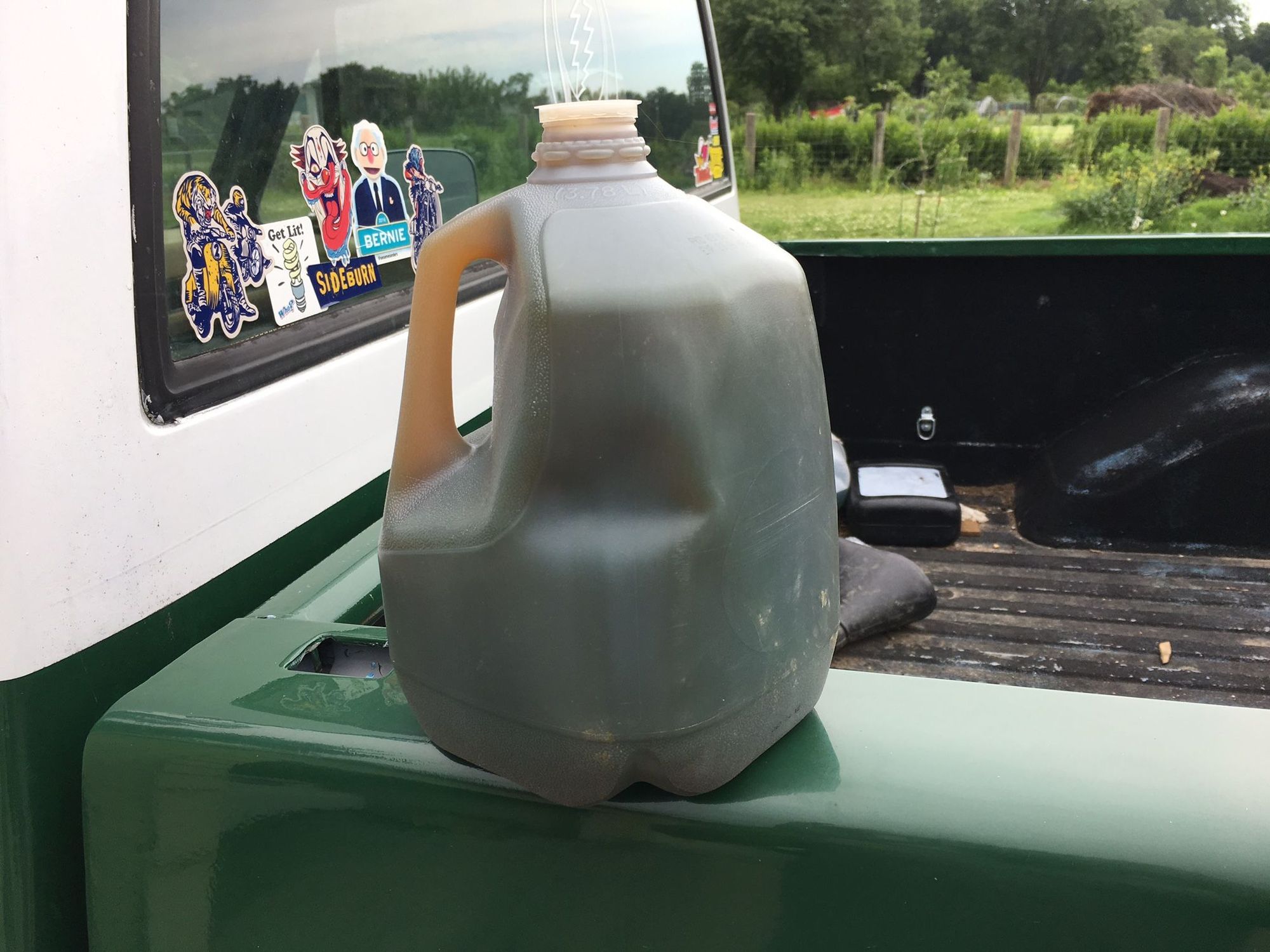
Is it possible that it was just super dirty in there and the coolant just couldn't shed the heat of highway speed driving? This is the 2nd time I've flushed using an additive.
This is the new lower radiator hose:
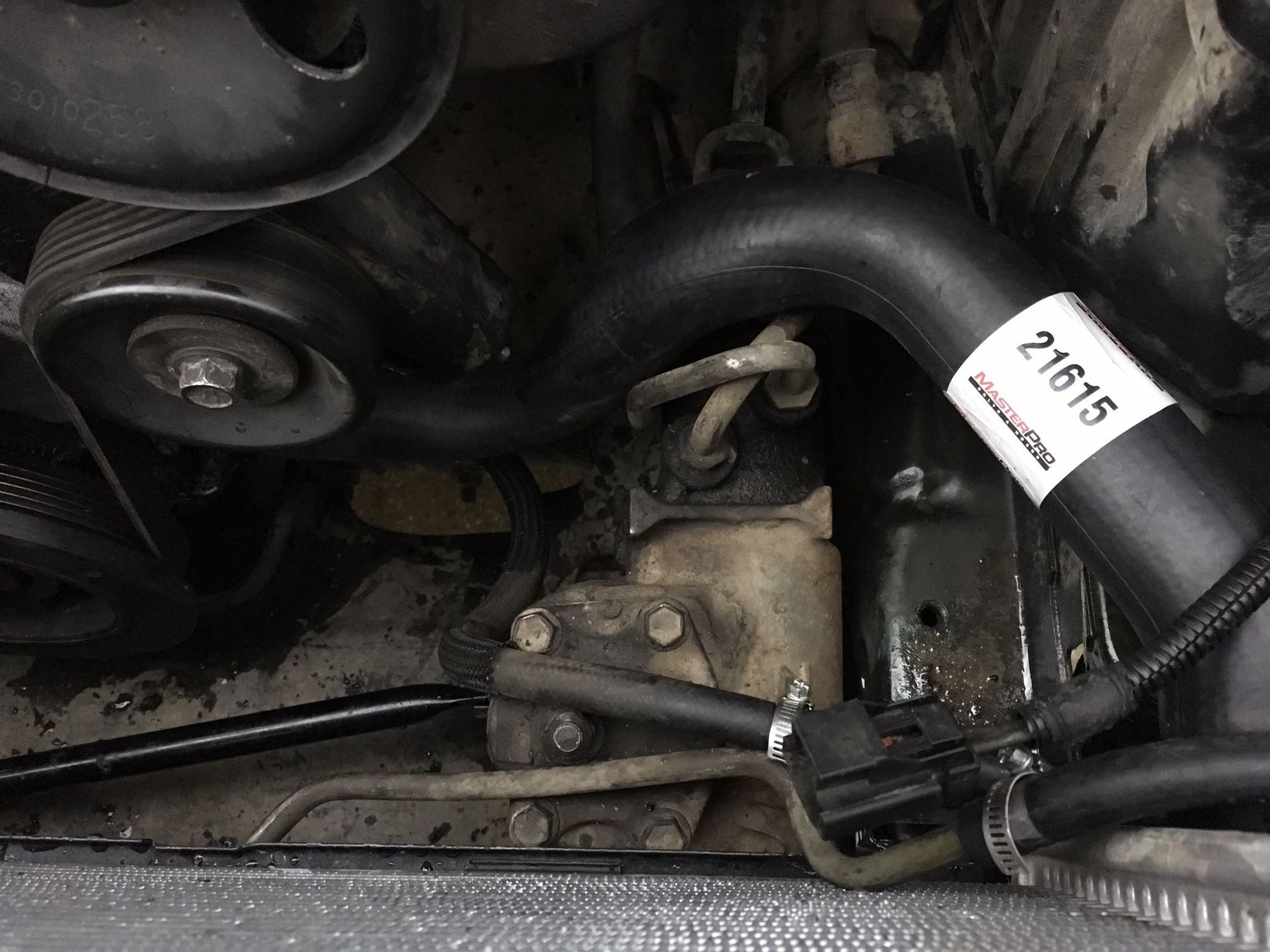
The parts store had a LHD and a RHD hose (for LHD or RHD radiator?) and I simply brought in the old one to compare and get the same one. I got the LHD one. Actually they didn't have the RHD one in stock so I couldn't compare it to that one or see what that one even looks like
But after installing it, one of the bends is half-way kinked by default!
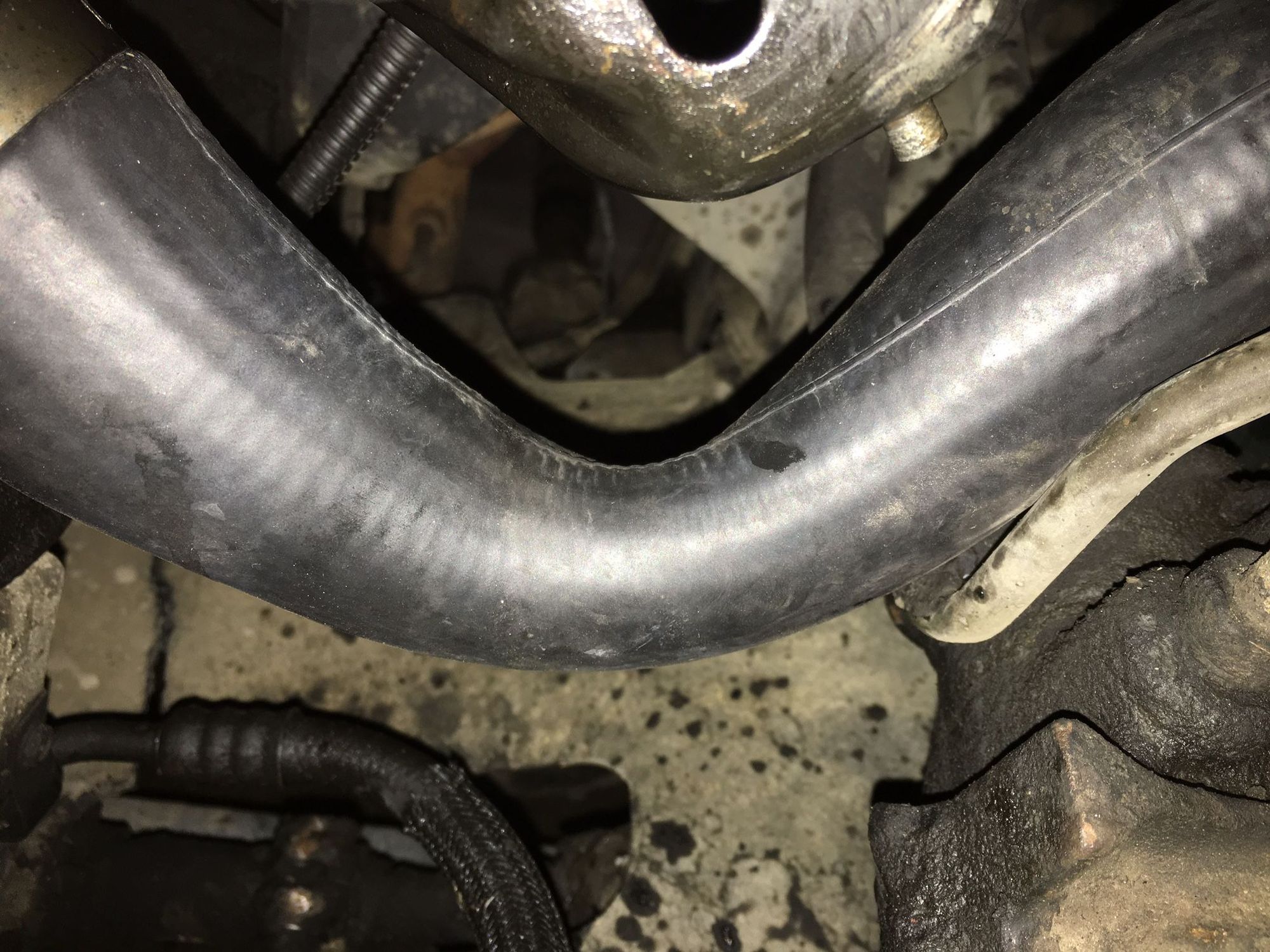
Do you think I could have the wrong radiator hose? I'm trying to remember if I got the RHD or LHD radiator... either way after getting the new radiator the old hoses fit it fine (or so I thought) but the oil cooler line fittings where on the opposite side than the old radiator.
It's a Left Hand Drive jeep and I guess the difference is where the gearbox is located, but I think what I might do is find a RHD radiator hose and see if it fits better... :icon_confused:
oh and one more thing, neither my old hose or the new hose had a spring inside it. Do I need the spring you think? Is there a universal hose spring I could use maybe??
[UPDATE: Amazon reviews http://amzn.to/2s981b3 say the hose comes a little too long from the factory and that it needs an inch chopped off. This will probably be all thats needed to remove the half-way-kinked bend I hope!]
All I had to do for the lower radiator hose was trim off about 3/4" off the end that goes to the water pump. Fits much better and there's now no more half-way-kink in the bend.
I finished the water pump install too.
Just got got back from a test drive. It's been greatly improved! But it's not perfect. It didn't boil over but the temp started to creep up VERY slowest after about 25 minutes of 75mph driving. Last time, when it overheated, it was after only 5 minutes of 65mph driving! AND its way hotter today then it was then, temp was just about 90 today. AND I didn't have the Water Wetter in the coolant like I did before. Right now I have 25/75 antifreeze/water (distilled).
i drove around different highways for about an hour experimenting with different driving speeds and using the heater core to controls temps further. I found that it was fine at 65 but not at 75mph!
So, much better, but like I said the temp did start to slowly creep up and that's not good enough when I have to drive 9 hours through hot-as-hell western Kansas. My plan is to get it perfect, and then add the Water Wetter which will insure that it can handle going up a mountain at high elevations when the water boils over easier. Actually, I'm told that the Water Wetter just allows you to run with more water which cools better than antifreeze, it raises the boiling temp.
I think I'll try flushing it some more with some sort of acid or detergent.
and I'm also fairly sure I'm going to put some hood vents in.
after the hour long test drive, I took some under hood temp readings with a temp gun. Here they are:
upper radiator hose: 219
lowwr radiator hose: 169
top of air box: 120
air intake near #2 cylinder: 188
air I take near #5: 215
Inner fender: 142
firewall: 127
Oh yeah and I ripped out the AC condenser from in front of the radiator.
The reason I removed the AC condenser was to free up air flow to the radiator and because the AC was toast anyways. All the gas leaked out.
Now I'm the biggest tree hugger ever and the environment was one of my top concerns when thinking about removing the compressor. I decided to quickly check the pressure in the AC system by quickly letting out a tiny bit through the valve and listening to it. When I did that the tiniest little puff came out and that was it. What would have been even more irresponsible is if I tried to recharge it with new gas and all that would have just leaked out in less than a year (I saw on one of the old service receipts that they recently charged the AC less than a year ago). Thankfully the ozone layer is recovering nicely (not at all related to climate change BTW).
And I attached the transmission oil cooler to the radiator now that the condenser is gone, and positioned to be in front of the belt-driven fan instead of the electric fan which is usually not spinning
Some info I've gathered on flushing out rusted, scaley cooling systems
Aside from the weak stuff from the auto parts stores, these are the chemicals people report using:
- oxalic acid - really good at removing rust. Can be purchased as "wood bleach" for about $10 a little tub from a good hardware store
- Sulphamic acid - really good at removing lime and hard water scale and old antifreeze crud. Can be found as "tile and grout cleaner"
- citric acid - this is what Mercadez Benz dealerships use supposedly. Can be purchased from them, or from a good hardware store
- Motorcraft VC-9. This is reportedly very very good stuff, it's used by Ford dealerships to clean the iron blocks and heads of diesel motors which have a problem with rust clogging the oil coolers somehow... Can be purchased from Ford dealerships for around $30
- dishwasher detergent - another one that many people swear by
- CLR - most people agree this is too aggressive for aluminum radiators but many people swear by it
I bought a little tub of oxalic acid for around $10 bucks from my local hardware store. Will be putting it into the cooling system very soon, keep it in there for a few days of driving, drain it out and then pull the thermostat out to take a peak and see if it's any cleaner in there.
Hood vents are in the mail, should arrive after the weekend.
Colorado or bust!!
I used the Oxalic acid

I drained the radiator through the lower hose then reattached it. Mixed the oxalic acid crystals with hot water and poured it into the radiator through the filler neck. The crystals didn't dissolve in the warm water right away though and I had to kinda spoon it all in there.
After driving it around for two days, I drained it and this is what came out:

This time I completely flushed the system and removed the thermostat. The thermostat had a yellowish coating on it. At first I thought the metal was etched by the acid but I could scratch off the coating with a knife.
And this is what the inside of the head's coolant passages looked like after the acid flush:

For comparison, this is what it looked like before the acid flush but after flushing with both Blue Devil and Prestone:

So much better but not squeaky clean.
I'm not sure if I should be concerned about the yellow coating inside there or not, but when I filled the cooling system back up I put another bottle of Blue Devil flush additive in there with distilled water and now I'm driving it around and will flush that all out today or tomorrow.
I drove for about an hour on the interstate today and the needle never started creeping up at all! Stayed put right at around 200. (I have a 180 thermostat and will put a 195 in there soon).
So.. All fixed!!!
I flushed the cooling system for hopefully the last time today
Three days ago I filled the cooling system with pure tap water and one bottle of Blue Devil radiator flush. This is what came just now:

So as you can see there was plenty of rust/crud that the flush additive was able to get out after the oxalic acid. It also removed most of the yellow coating:
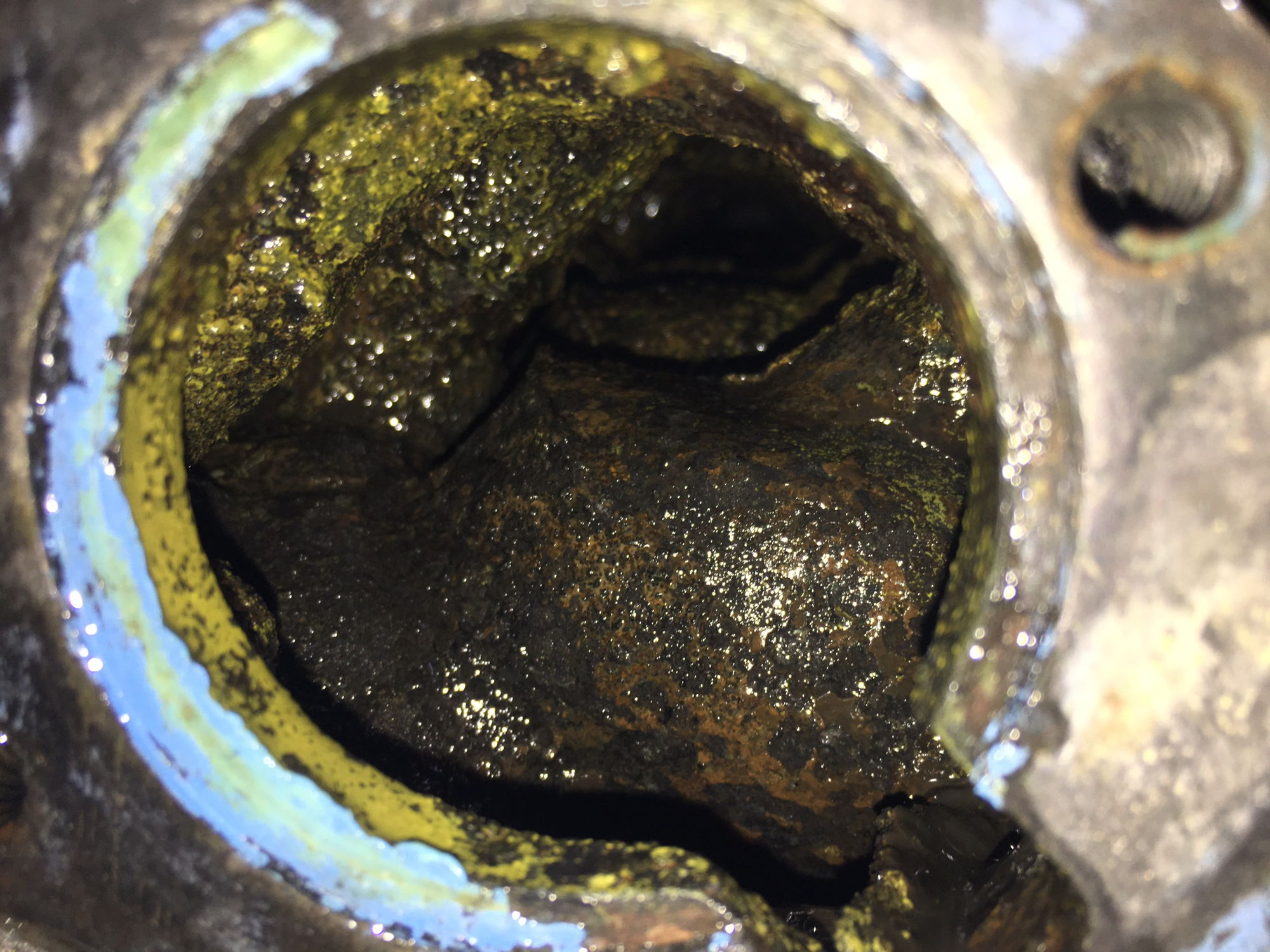
Not perfect but looking more and more like bare metal
The thermostat before and after the blue devil flush:
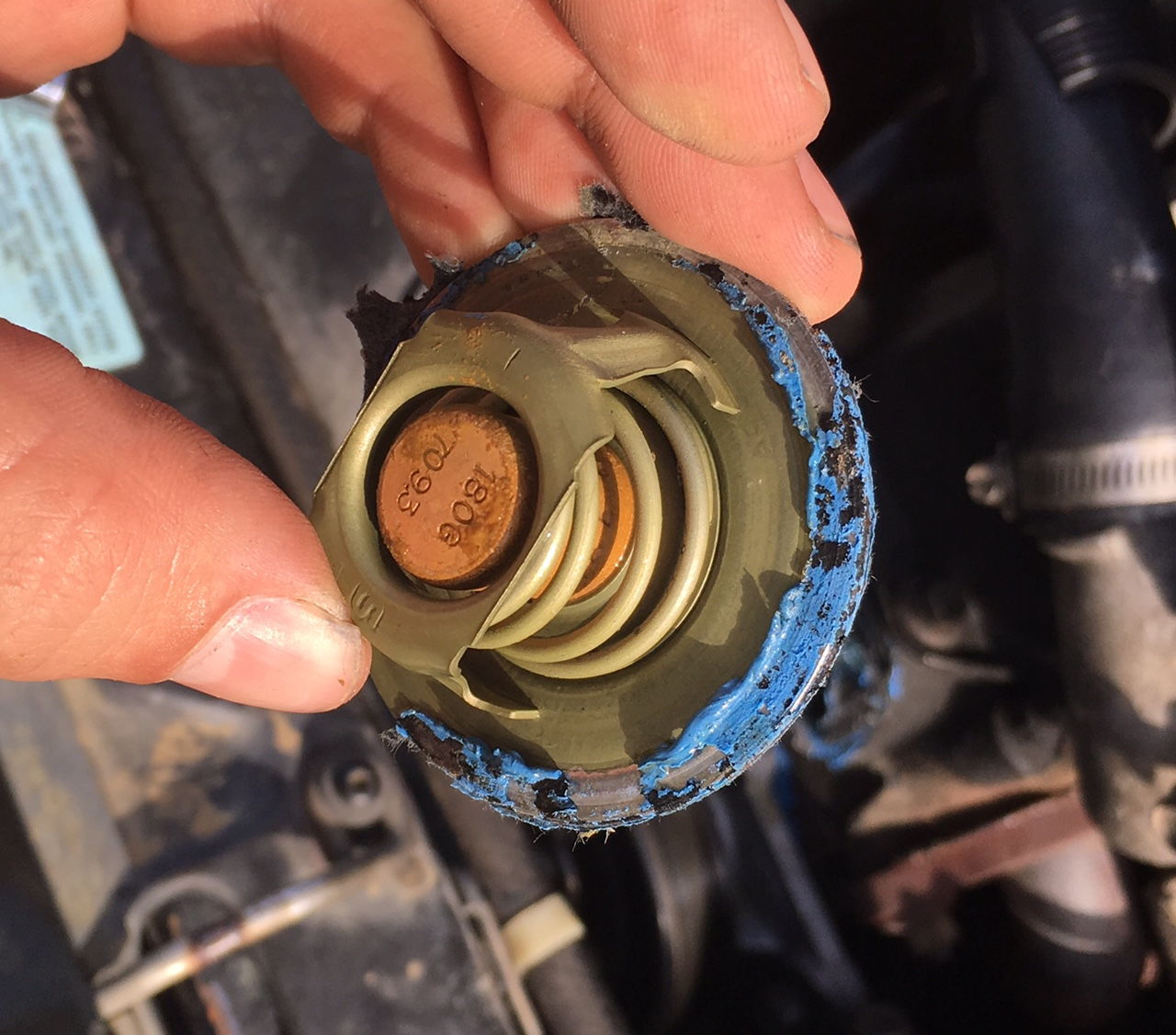
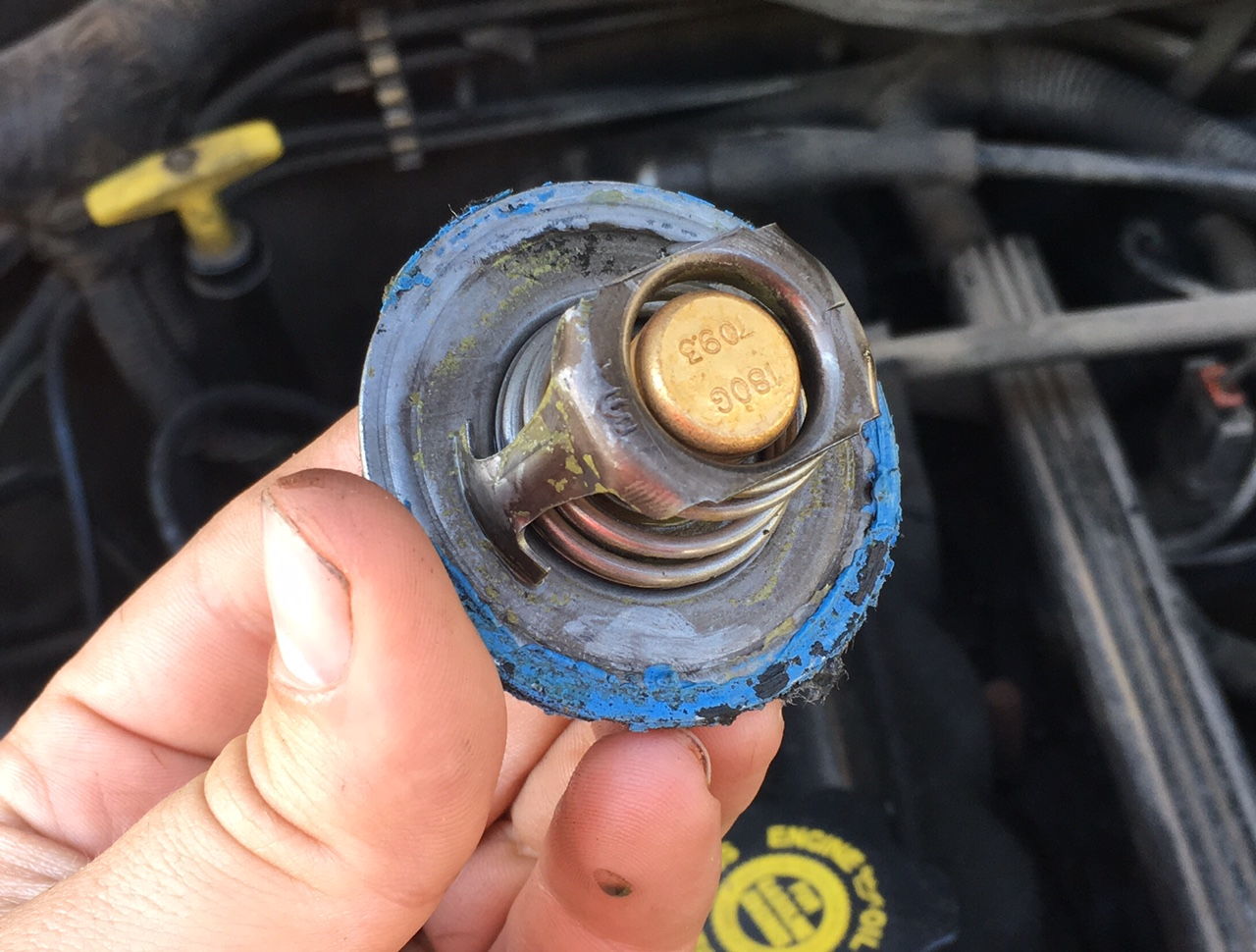
And here's the inside of the aluminum thermostat housing, I think the oxalic acid noticeably etched it:

After I put it all back together I hoped in my pickup to get some distilled water and antifreeze but the fuel hose was dry rotted and I spilled half my gas tank in the Oreilly's parking lot. A day working on my trucks is still better than a day in the office though!
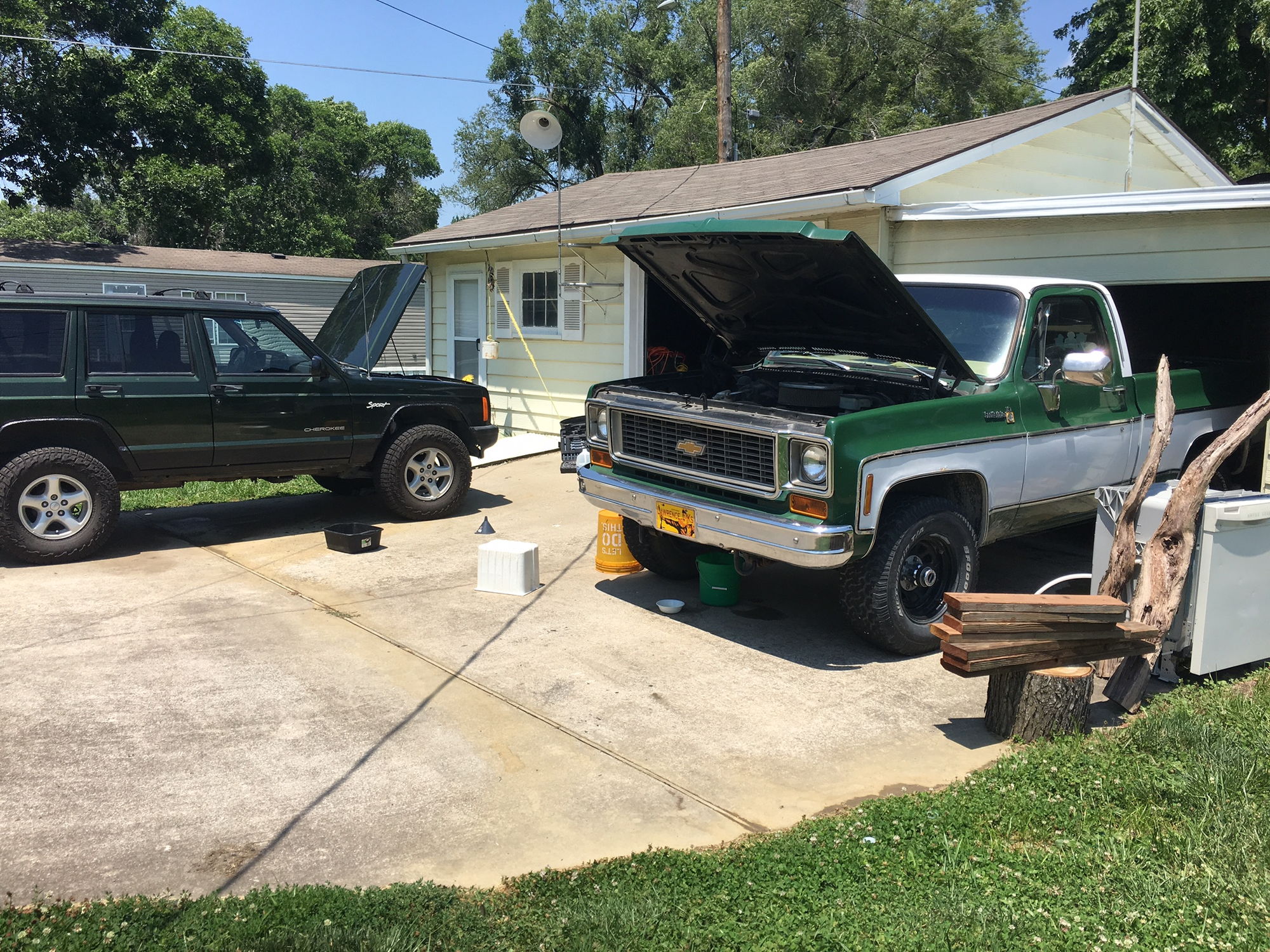
--------------
Just got back from our excursion to the Rocky Mountains of Colorado!
The jeep did great. It was our chariot of fire, because it took us to heaven and back. And because it runs on fire. It was rare to see the temp gauge needle left of the 210 mark. A few times I had to pull over to let it cool down, especially up highway mountain passes. When driving in the flat plains, I figured out that I could keep the temps stable just above 210 by keeping the speed under 65. The temp gauge did spike up one time, into the red zone, but it didn't boil over somehow.
So I wouldn't say I have the overheating problem totally figured out but it is definitely improved. I'm sure more flushing and rust removal is what it needs. And good electric cooling fans.
But it crawled up the mountains like a champ! Engine was not hot at all in 4 Low. The engine is just happier at the speed!
While I'm sure that the hood vents helped the underhood temps dramatically, I wonder if the money could have been better spend on electric cooling fans. My co driver's opinion of belt-driven fans is that they HURT the cooling at high speeds because they don't spin fast enough to keep up with the air flowing past the vehicle and thereof they actually HURT instead of help. It makes a little sense I guess
--------------
Update: I drove the Jeep to Wichita for Thanksgiving and it was an especially hot Thanksgiving weekend at 75*F that day! And, guess what, the Jeep overheated. Twice! I slowed waaaaaay down to 60 mph and when I got to a rest stop we let it cool down for a while and then I aired up the tires from 30 psi to 40 psi. Another 1.5 hours of driving, didn't over heat at all! I even drove the speed limit at 75. Weird!
--------------
Update: The Jeep was running hot again after 1.5 hrs of highway driving at about 75mph. It got up to 245 degrees F, but didn't boil over. I already had the tires aired up to 45psi. I used the heater and slowed down to 60mph and that was enough to get it back home.
Last week I had a professional shop check for combustion gases in the coolant and it was all negative. I also tested the compression myself and each cylinder was 140-150psi. No bad head gasket!
I'm installing an aluminum radiator outfitted with 3 10" cooling fans and a fan shrowd from dirtboundoffroad.com. I also have a new "high flow" water pump, and I'm going to put a spring inside the lower radiator hose to make sure its not collapsing even though I don't think that it is.
--------------
LAST AND FINAL UPDATE:
The head gasket was leaking because the head was warped. I fixed it and now it's not overheating.
